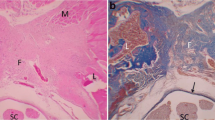Abstract
Purpose
The consequences from the injection of different types of drugs in the epidural space remains unknown. Increasing evidence suggests that localized inflammation, fibrosis, and arachnoiditis can complicate sequential epidural blockades, or even epidural contrast injection. We investigate the in vivo effect of epidural injections in the epidural space in an animal model.
Materials and Methods
A group of ten male adult pigs, five punctures to each at distinct vertebral interspaces under general anesthesia, were examined, testing different drugs, used regularly in the epidural space (iopamidol, methylprednisolone acetate, ropivacaine). Each site was marked with a percutaneous hook wire marker. Histological analysis of the epidural space, the meninges, and the underlying spinal cord of the punctured sites along with staining for caspase-3 followed 20 days later.
Results
The epidural space did not manifest adhesions or any other pathology, and the outer surface of the dura was not impaired in any specimen. The group that had the contrast media injection showed a higher inflammation response compared to the other groups (P = 0.001). Positive staining for caspase-3 was limited to <5% of neurons with all substances used.
Conclusion
No proof of arachnoiditis and/or fibrosis was noted in the epidural space with the use of the above-described drugs. A higher inflammation rate was noted with the use of contrast media.





Similar content being viewed by others
References
Aldrete JA (1995) Epidural fibrosis after permanent catheter insertion and infusion. J Pain Symptom Manag 10:624–631
Larsen JJ, Svendsen O, Andersen HB (1986) Microscopic epidural lesions in goats given repeated epidural injections of morphine: use of a modified autopsy procedure. Acta Pharmacol Toxicol (Copenh) 58:5–10
Sghirlanzoni A, Marazzi R, Pareyson D et al (1989) Epidural anaesthesia and spinal arachnoiditis. Anaesthesia 44:317–321
Sklar EM, Quencer RM, Green BA et al (1991) Complications of epidural anesthesia: MR appearance of abnormalities. Radiology 181:549–554
Arendt K, Segal S (2008) Why epidurals do not always work. Rev Obstet Gynecol 1:49–55
Gerner P, Stricharzt GR (2008) Sensory and motor complications of local anesthetics. Muscle Nerve 37:421–425
Perez-Castro R, Patel S, Garavito-Aguilar ZV et al (2005) Cytotoxicity of local anesthetics in human neuronal cells. Anesth Analg 108:997–1007
Bender A, Elstner M, Paul R, Straube A (2004) Severe symptomatic aseptic chemical meningitis following myelography: the role of procalcitonin. Neurology 63:1311–1313
Widmer WR, DeNicola DB, Blevins WE et al (1992) Cerebrospinal fluid changes after iopamidol and metrizamide myelography in clinically normal dogs. Am J Vet Res 53:396–401
Schmeichel AM, Schmelzer JD, Low PA (2003) Oxidative injury and apoptosis of dorsal root ganglion neurons in chronic experimental diabetic neuropathy. Diabetes 52:165–171
Kitamura A, Sakamoto A, Aoki S et al (1996) Epiduroscopic changes in patients undergoing single and repeated epidural injections. Anesth Analg 82:88–90
Suzuki K, Masawa N, Takatama M (2001) Pathogenesis of état criblé in experimental hypertensive rats. J Stroke Cerebrovasc Dis 10:106–112
Torres D, Bauso Toselli L, Vecchi E et al (1993) Spinal arachnoiditis as a complication of peridural anesthesia. Medicina (B Aires) 53:391–396
Weston-Hurst E (1955) Adhesive arachnoiditis and vascular blockage caused by detergents and other chemical irritants: an experimental study. J Path Bact 70:167–178
Haughton VM, Ho KC (1982) Arachnoid response to contrast media: a comparison of iophendylate and metrizamide in experimental animals. Radiology 143:699–702
Kanny G, Pichler W, Morisset M et al (2005) T cell–mediated reactions to iodinated contrast media: evaluation by skin and lymphocyte activation tests. J Allergy Clin Immunol 115:179–185
Lerch M, Keller M, Britschgi M et al (2007) Cross-reactivity patterns of T cells specific for iodinated contrast media. J Allergy Clin Immunol 119:1529–1536
Haisa T, Todo T, Kondo T (1995) Lumbar adhesive arachnoiditis following attempted epidural anesthesia. Neurol Med Chir (Tokyo) 35:107–109
Quiles M, Marchisello P, Tsairis P (1978) Lumbar adhesive arachnoiditis. Aetiologic and pathologic aspects. Spine 3:45–50
Johnson ME, Uhl CB, Spittler KH et al (2002) Mitochondrial injury and caspase activation by the local anesthetic lidocaine. Anesthesiology 101:1184–1194
Werdehausen R, Braun S, Essmann F et al (2007) Lidocaine induces apoptosis via the mitochondrial pathway independently of death receptor signaling. Anesthesiology 107:136–143
Boselli E, Duflo F, Debon R et al (2003) The induction of apoptosis by local anesthetics: a comparison between lidocaine and ropivacaine. Anesth Analg 96:755–756
Park CJ, Park SA, Yoon TG et al (2005) Bupivacaine induces apoptosis via ROS in the Schwann cell line. J Dent Res 84:852–857
Green DR, Kroemer G (2004) The pathophysiology of mitochondrial cell death. Science 305:626–629
Durant PA, Yaksh TL (1986) Epidural injections of bupivacaine, morphine, fentanyl, lofentanil, and DADL in chronically implanted rats: a pharmacologic and pathologic study. Anesthesiology 64:43–53
Acknowledgments
This work was funded by the National and Kapodistrian Athens University through the Special Research Account (ELKE) of the 2nd Department of Anesthesiology, Medical School, Attikon University Hospital, University of Athens, Athens, Greece.
Conflict of Interest
The authors declare that they have no conflict of interest.
Author information
Authors and Affiliations
Corresponding author
Rights and permissions
About this article
Cite this article
Kitsou, MC., Kostopanagiotou, G., Kalimeris, K. et al. Histopathological Alterations after Single Epidural Injection of Ropivacaine, Methylprednizolone Acetate, or Contrast Material in Swine. Cardiovasc Intervent Radiol 34, 1288–1295 (2011). https://doi.org/10.1007/s00270-011-0159-1
Received:
Accepted:
Published:
Issue Date:
DOI: https://doi.org/10.1007/s00270-011-0159-1




